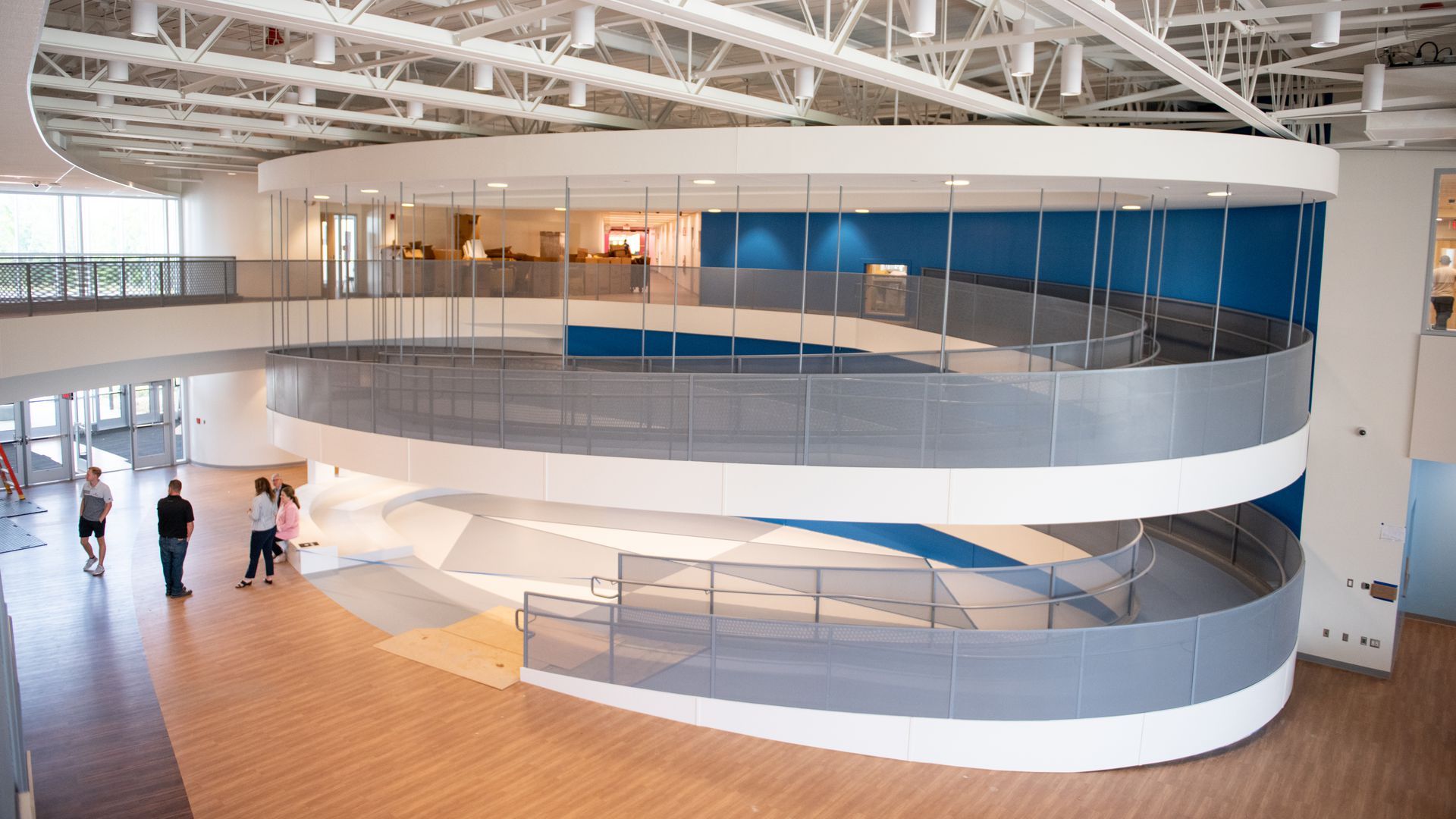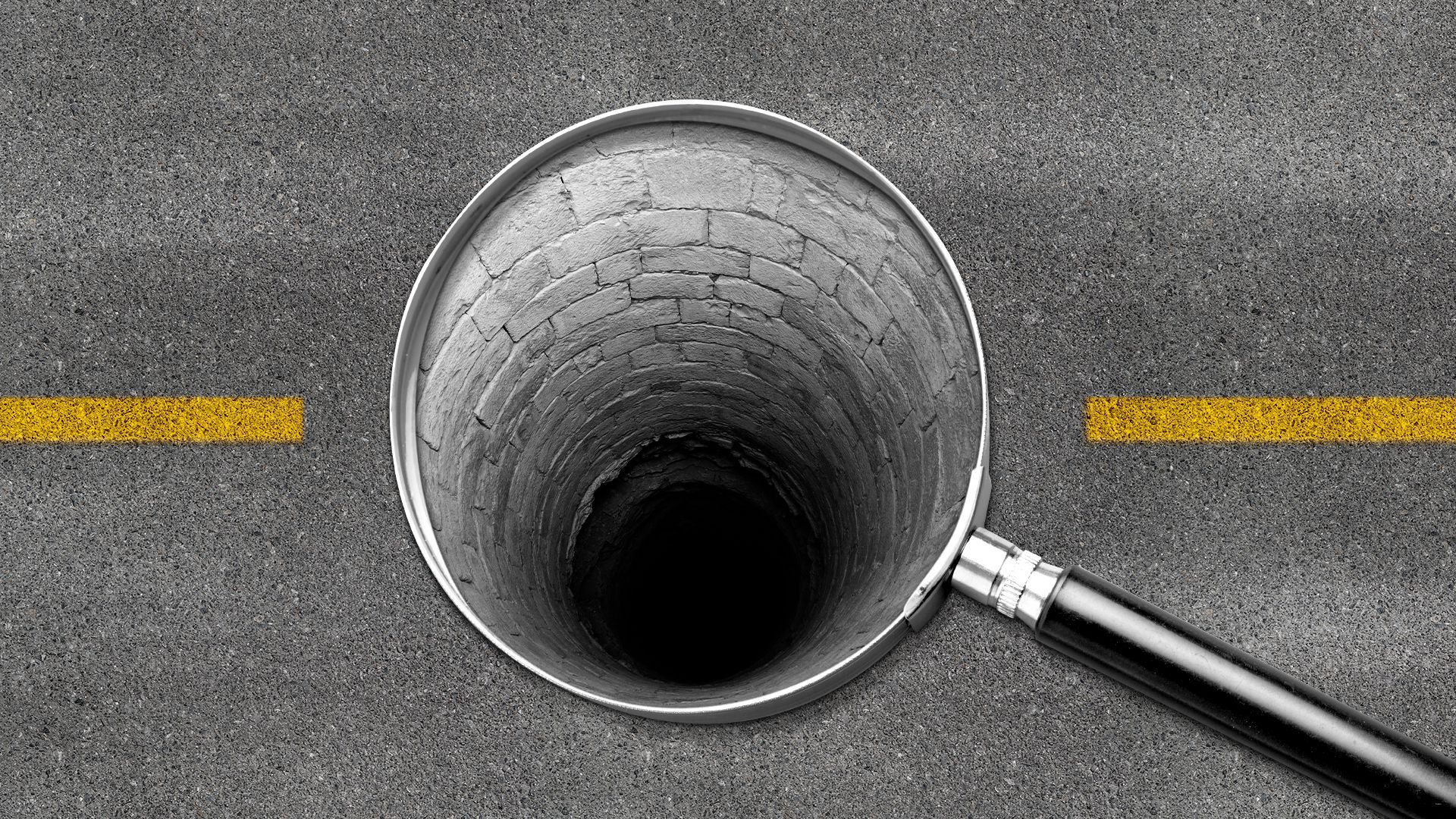| | | | | | | | | | | Axios What's Next | | By Jennifer A. Kingson, Joann Muller and Alex Fitzpatrick · Aug 15, 2022 | | Elementary, middle and high schools as you knew them are undergoing big changes, Jennifer reports in her story today. Today's Smart Brevity count: 1,052 words ... 4 minutes. | | | | | | 1 big thing: The K-12 school of the future |  | | | The new Ehrman Crest Elementary/Middle School, opening this fall in Seneca Valley, Pa., has a dynamic interior ramp, lots of windows and transparent space, and visual connections to the outdoors. Rendering courtesy of CannonDesign | | | | The hallway-and-classroom model of school architecture is out, Jennifer A. Kingson reports. Instead, forward-thinking schools feature flexible "learning spaces," wellness rooms, touch-free lighting and plumbing — and of course, souped-up ventilation. Why it matters: Lots of pandemic relief money is earmarked for school improvements, so there's a big window of opportunity for construction projects that boost pedagogy as well as students' physical and mental wellbeing. Driving the news: Just as teaching shifts from a "sage on a stage" to a "whole child" approach — which emphasizes collaboration, small groups and hands-on learning — some districts find themselves with cash for complementary architecture. - Desirable features include transparent walls connecting students to the outdoors, movable partitions and furniture, "calming spaces" to address mental health, and "learning stairs" — steps that double as amphitheater-style seats.
- Other modern touches, like gender-neutral bathrooms, bigger access ramps and whiteboard walls, are also on the wish list.
- Cafeterias are more likely to be open areas for eating, studying and socializing, while libraries are turning into "maker spaces" with 3D printers and other tech.
- Space that can be used for educational gaming, virtual reality and coding lessons is at a premium.
What they're saying: "Classroom design has evolved," says Troy Hoggard, an architect at CannonDesign. He worked with the Children's Museum of Pittsburgh on the Ehrman Crest Elementary/Middle School in Seneca Valley, Pennsylvania, opening this fall. - The school's corridors double as learning spaces and include such touches as a solar calendar that projects the day and time of year on the floor.
- The playground is designed for ready access to nature, with walking trails where kids can look for frogs and crickets.
Architects are also giving more prominence to automotive and culinary arts programs, in recognition that schools aren't just for the college-bound. - Historically, rooms for such programs "were kind of at the back of the school, and only kids that were taking those courses would go there," said Laura Sachtleben, who leads the education practice at Stantec, a design and construction firm.
- "Now, they're being celebrated, they're being pulled to the front of the facility," she said. "There's lots of glass and visibility, so that all students can see what's happening in these other programs and get excited about them."
Yes, but: Nationwide, school construction aspirations are being tempered by the rising cost of materials and labor, worker shortages and supply-chain problems. - And many districts in low-income neighborhoods are struggling to keep their buildings from falling apart, never mind splashy architectural upgrades.
The bottom line: At schools built decades ago, the need for pandemic-era upgrades is calling attention to any number of wish-list items. - "Now we have an opportunity to reach a broader audience that hadn't been thinking about why schools need to change," says Vaughn Dierks, a partner at Wold Architects and Engineers who specializes in school design.
Share this story. |     | | | | | | 2. New York, with fewer cars |  | | | Illustration: Aïda Amer/Axios | | | | New York City is a step closer to tolling drivers for entering Midtown or Lower Manhattan, Alex Fitzpatrick reports. Why it matters: Advocates of such plans, called "congesting pricing," argue that they help reduce the number of cars in cities while raising money for subways, buses and other driving alternatives. Details: The Metropolitan Transportation Authority, which runs public transit in and around the Big Apple, last week released a long-awaited congestion pricing assessment. - Implementing congestion pricing would decrease car traffic by about 15%-20% within the toll zone, the report found, as well as improve local air quality and slightly boost public transit ridership.
Be smart: Other cities, like Singapore and London, have long had generally successful congestion pricing rules. The other side: Some car commuters say congestion pricing is an undue burden, while others question whether it would have the promised financial impacts. What's next: The public is invited to comment on the MTA's findings, then federal regulators will have their say. If and when the feds approve the plan, it could take a year or longer to install the requisite tolling tech. - If New York's efforts are successful, other big American cities with lots of traffic could follow suit.
|     | | | | | | 3. Wastewater surveillance goes mainstream |  | | | Illustration: Natalie Peeples/Axios | | | | Wastewater disease surveillance, which proved its mettle during the COVID-19 pandemic, is now helping experts track recent outbreaks of monkeypox and polio, Axios' Tina Reed and Arielle Dreher report. The big picture: The technique existed before COVID, but the pandemic prompted the creation of the National Wastewater Surveillance System. - A number of universities also banded together to create their own wastewater testing networks.
The WastewaterSCAN initiative, co-led by Stanford researcher Ali Boehm, has found that detecting COVID in wastewater samples correlates very well to community spread. - It's now looking for other diseases, like influenza A, respiratory syncytial virus (RSV) and monkeypox.
Be smart: Polio was recently found in New York City wastewater samples, suggesting an outbreak first spotted in nearby counties has spread there. Read the rest. |     | | | | | | A message from Axios | | Six steps for clearer business communications | | |  | | | | Axios HQ's checklist shares six elements of Axios' Smart Brevity® method – simple steps to help you think more clearly, communicate more effectively and keep stakeholders engaged. It works for all your vital updates, from internal team priorities to client or investor communications. Get the free checklist | | | | | | 4. The EV charging haves and have-nots |  Data: SparkCharge; Map: Erin Davis/Axios Visuals Automakers and startups spent as much as $3.5 billion on U.S. electric vehicle charging last year — but the effort is still excluding predominately Black and brown communities, Axios' Alan Neuhauser reports. Why it matters: Historically underserved and lower-income Americans have the most to gain from the lifetime savings of an EV. What's happening: So-called EV charging deserts have been a persistent challenge — in cities and rural communities. - EV charging startup SparkCharge mapped such deserts in Boston (above), Dallas, Los Angeles and San Francisco.
- The gaps — marked in red — overlap with mostly Black and brown communities.
Sign up for Axios Pro Climate Deals to read the whole story. |     | | | | | | 5. One fun thing: Getting your (Star)bucks back |  | | | Illustration: Sarah Grillo/Axios | | | | A Starbucks customer has filed a class-action lawsuit alleging the coffee giant is ripping off customers by not offering refunds for gift card balances, Axios' Lewis Kamb reports. Driving the news: The lawsuit alleges Starbucks hasn't established a way for customers to get refunds for their unused gift card balances in Massachusetts and at least 10 other states with relevant laws. - The suit seeks monetary damages and legal costs and fees to be determined by the court, plus an order requiring Starbucks to comply with refund laws and "undertake a corrective advertising campaign" about them.
A Starbucks spokesperson told Axios on Friday that the company was still reviewing the claims to determine whether it would make any comments. Yes, but: Anybody can sue anybody for almost anything, and there's no guarantee this actually goes anywhere. Read the rest. |     | | | | | | A message from Axios | | Six steps for clearer business communications | | |  | | | | Axios HQ's checklist shares six elements of Axios' Smart Brevity® method – simple steps to help you think more clearly, communicate more effectively and keep stakeholders engaged. It works for all your vital updates, from internal team priorities to client or investor communications. Get the free checklist | | | | A hearty thanks to What's Next copy editor Kathie Bozanich. Was this email forwarded to you? Get your daily dose of What's Next magic by signing up here for our free newsletter. |  | | Are you a fan of this email format? It's called Smart Brevity®. Over 300 orgs use it — in a tool called Axios HQ — to drive productivity with clearer workplace communications. | | | | | | Axios thanks our partners for supporting our newsletters. If you're interested in advertising, learn more here.
Sponsorship has no influence on editorial content. Axios, 3100 Clarendon Blvd, Arlington VA 22201 | | | You received this email because you signed up for newsletters from Axios.
Change your preferences or unsubscribe here. | | | Was this email forwarded to you?
Sign up now to get Axios in your inbox. | | | | Follow Axios on social media:    | | | | | |









No comments:
Post a Comment